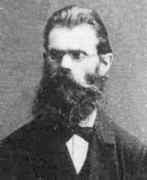Person: Reye, Karl Theodor

Theodor Reye worked in Geometry and Projective Geometry.
Mathematical Profile (Excerpt):
- Georg Reye had been born in Ritzebüttel and he lived there all his life, being a local businessman.
- Theodor attended school in Hamburg, being a pupil at the famous Johanneum.
- In Zürich, Reye was taught by Kurt Culmann (1821-1881), who had held the Chair of Engineering Sciences since the Polytechnikum was founded in 1855.
- The Chair of Mathematical Physics at the Polytechnikum in Zürich had been held by Rudolf Clausius since the founding of the Polytechnikum and, despite the influence of Culmann which we mention below, it was Clausius who influenced Reye to move from mechanical engineering to mathematical physics.
- Reye, following Clausius's advice, then went to the University of Göttingen to undertake research for his doctorate in Mathematical Physics.
- The background to Reye's thesis is the following.
- Reye's thesis sought to show that Regnault's experimental results were consistent with the kinetic theory of gases and provide further support for Clausius's theories.
- A couple of years later, Reye wrote a paper Die Ausdehnung der atmosphärischen Luft bei der Wolkenbildung Ⓣ(The expansion of the atmospheric air in cloud formation) (1865) applying the kinetic theory of gases to the expansion of air during the formation of clouds.
- These lectures had the effect of changing Reye's interests more towards mathematics, although he continued his interest in mathematical physics.
- After the award of his doctorate, Reye returned to the Polytechnikum in Hannover where he taught for a while before presenting his habilitation thesis to the Polytechnikum in Zürich and becoming a lecturer there in 1863.
- In Zürich he became a colleague of Kurt Culmann, who had taught him as an undergraduate, and it was now Culmann who had a major influence on the direction of Reye's research.
- Under this influence, Reye's early interest in mathematical physics and meteorology turned to an interest in geometry while he continued to hold the lectureship in mathematical physics at Zürich.
- Culmann's fundamental monograph Die graphische Statik (Graphical Statics) was published in 1865 but Reye was by this time deeply involved in studying geometrical methods similar to the ideas of projective geometry contained in von Staudt's Geometrie der Lage Ⓣ(Geometry of position) (1847).
- The second volume of Reye's Geometrie der Lage Ⓣ(Geometry of position) appeared in 1868.
- When Reye published a third edition between 1886 and 1892, it was as a three volume work and two further three-volume editions were published - the fourth between 1899-1910, and the fifth between 1909-1923.
- Reye had been an assistant to Joseph Wolfgang von Deschwanden (1819-1866), the professor of descriptive geometry, and taught descriptive geometry at Zürich after Deschwanden became ill.
- Reye also taught projective geometry believing that the two courses should be linked.
- This unhappy situation for Reye was solved by his move to Aachen.
- Two mathematics chairs were founded at this time, the first in Mathematics which was filled by Elwin Christoffel and the second in Geometry and Mechanics which was filled by Reye.
- Both Christoffel and Reye considered it their patriotic duty to assist in making the University of Strasbourg a German university.
- Reye, who was a geometer in the tradition of Steiner and von Staudt, produced about a dozen doctorates during this time.
- In 1872 Reye published the book Die Wirbelstürme, Tornados und Wettersäulen in der Erd-Atmosphäre mit Berücksichtigung der Stürme in der Sonnen-Atmosphäre Ⓣ(Hurricanes, tornadoes and weather pillars in the earth's atmosphere with consideration of the storms in the solar atmosphere).
- After he retired in 1909 Reye remained in Strasbourg until the end of World War I.
- Reye's work in geometry included a study of conics, quadrics and projective geometry.
- Reye's standing as a mathematician is illustrated by the fact that Gösta Mittag-Leffler, the founder of the journal, interrupted his honeymoon so that he could personally speak to Reye and ask for his support for the new journal by submitting a paper for publication.
- Reye's book Synthetische Geometrie der Kugeln, mit einer Einleitung in die analytische Geometrie der Kugelsysteme Ⓣ(Synthetic geometry of spheres, with an introduction to the analytic geometry of the sphere systems) was published in 1879 with an Italian translation being published two years later.
- It is not unreasonable to ask why Reye's work is not better known today.
- Part of the reason must be that some of Reye's work was later interpreted in the geometry set up by Corrado Segre, in particular it was interpreted in the setting of Segre manifolds.
- Reye's work on linear manifolds of projective plane pencils and of bundles on spheres went into the Segre manifold setting.
- Finally we note that although David Hilbert had a high opinion of Reye's work, their approach to geometry was very different.
- Hilbert proposed a purely axiomatic method in geometry while Reye rejects everything that cannot be justified with geometric intuition.
Born 20 June 1838, Ritzebüttel, near Cuxhaven, Germany. Died 2 July 1919, Würzburg, Germany.
View full biography at MacTutor
Tags relevant for this person:
Origin Germany
Thank you to the contributors under CC BY-SA 4.0! 

- Github:
-

- non-Github:
- @J-J-O'Connor
- @E-F-Robertson
References
Adapted from other CC BY-SA 4.0 Sources:
- O’Connor, John J; Robertson, Edmund F: MacTutor History of Mathematics Archive
